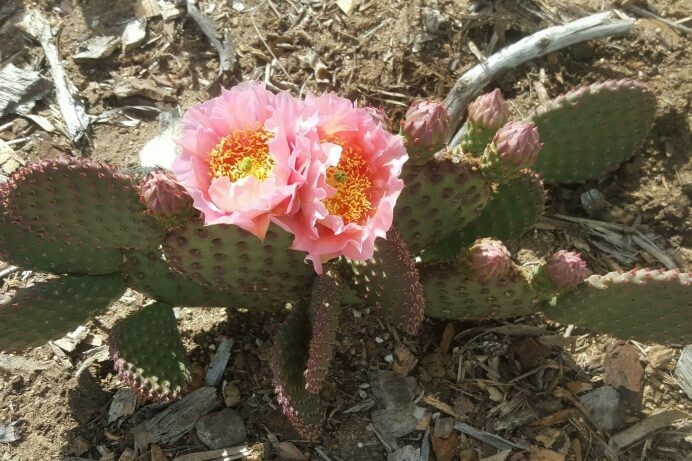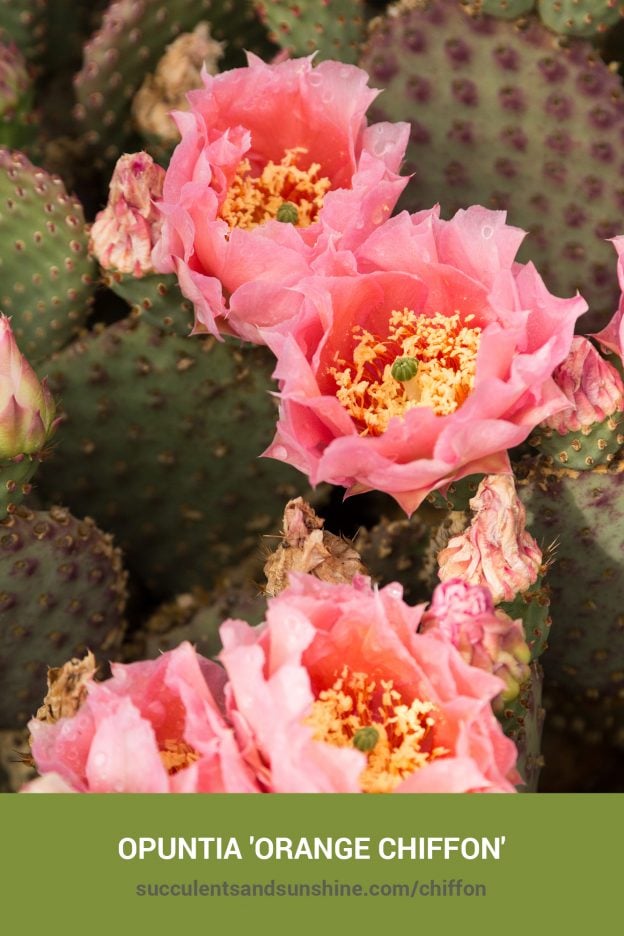This cactus is hardy enough to stand up to frost and grows in a thick shrub-like shape. The green pads of the cactus become a purplish hue when the temperature drops, and it produces striking orange flowers in the springtime.
Table of Contents
Care and Propagation Information
Opuntia ‘Orange Chiffon’ is an excellent shrub-like cactus that can be used to create a natural barrier in the garden.
Watering
During the winter months, Opuntia ‘Orange Chiffon’ should be watered less frequently. It’s best to use the “soak and dry” method, where you allow the soil to dry out completely before giving it a thorough soaking.
Where to Plant
Orange Chiffon is hardy in temperatures as low as -20°F (-28.8°C) and thrives in either full or partial sunlight.
Put a plant in a spot in your garden that is exposed to 6 hours of direct sunlight daily.
How to Propagate Opuntia ‘Orange Chiffon’
To propagate Opuntia ‘Orange Chiffon’, take a clean, sharp knife or pair of scissors and cut off a stem from the main plant. Let the cutting sit for a few days to form a protective callous layer, then plant in a soil that drains well. Water the cuttings when the soil has completely dried out.
This post provides an in-depth look at how to propagate cactus pads correctly and safely.
Care and Propagation Information
General Care for Opuntia ‘Orange Chiffon’
Watering
During the winter months, Opuntia ‘Orange Chiffon’ should be watered less frequently. It’s best to use the “soak and dry” method, where you allow the soil to dry out completely before giving it a thorough soaking.
Where to Plant
Orange Chiffon is hardy in temperatures as low as -20°F (-28.8°C) and thrives in either full or partial sunlight.
Put a plant in a spot in your garden that is exposed to 6 hours of direct sunlight daily.
How to Propagate Opuntia ‘Orange Chiffon’
To propagate Opuntia ‘Orange Chiffon’, take a clean, sharp knife or pair of scissors and cut off a stem from the main plant. Let the cutting sit for a few days to form a protective callous layer, then plant in a soil that drains well. Water the cuttings when the soil has completely dried out.
This post provides an in-depth look at how to propagate cactus pads correctly and safely.
FAQ
How do you care for orange chiffon Opuntia?
During winter dormancy, it is recommended to water Opuntia ‘Orange Chiffon’ sparingly. Adopting the “soak and dry” method is advised, which entails letting the soil dry out completely between waterings.
How often do you water Opuntia?
Every fortnight to monthly.
How do I know if my prickly pear cactus is overwatered?
Signs that a plant has been given too much water include discolored leaves or stems (usually brown or blackish), wilting or soggy stems, visible rotting, and plants deteriorating quickly.
How do you take care of a prickly pear cactus in the winter?
These plants also require limited water. They can go weeks without watering, and they should never be overwatered.
Prickly pear cacti need plenty of light to thrive, especially when the weather is warm. They can take direct sun and hot temperatures without issue. When the weather is cooler, they should be kept indoors near a window that provides bright indirect light. As for water, it’s best to only water these plants when necessary. Overwatering can be a problem, so it’s best to wait until the soil has completely dried out before giving them more.
How big do orange chiffon Opuntia get?
We are fortunate to be able to offer clones of Tom Jesch’s Opuntia ‘Orange Chiffon’, a special hybrid of Opuntia aurea created by Waterwise Botanicals. This variety is hardy enough to survive temperatures as low as -17F in our Colorado garden without any harm. In maturity, these plants can reach up to 2ft in height and 3ft in width.



